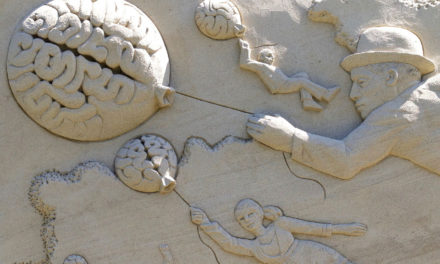Listen to Your Heart to Read Minds? Science Closer to Saying Yes
by Evelyn Reid
Originally published on Where’s Your Head?
July 6, 2017
Can you accurately read your heartbeat without taking your pulse? Then you might be able to read people’s emotional states as impressively as a Buddhist monk [1]. No promises, though.
One of the more intriguing research studies of the last year [2] was inspired by a 2015 paper published in Brain and Cognition [3]. Authored by a trio of University College London neuroscientists, they formally put forth the idea that your ability to accurately gauge your own body’s internal state, everything from your heart rate to your blood pressure to your body’s internal temperature, may be integral to effectively understanding what’s going on inside other people’s minds, a piece of the puzzle which hadn’t been actively considered before, at least not on a grand scale.
Know Thyself = Know Others?
Theory of Mind is the psychological concept that refers to a person’s ability to recognize and understand their own thoughts, beliefs, desires, intentions, perceptions, and feelings as well as their ability to infer what’s happening inside other people’s heads too, all this while fully aware that just because you know certain things and think a certain way doesn’t mean someone else does. Taking it a step further, this ability to understand another person’s mental state could lead an especially “aware” individual to predict that same person’s intentions and future behavior.
The field calls it ToM. You might call it social insight.
See Also: Feeding the Belly Brain
And: Truth or Hype: Does Green Tea Actually Make You Lose Weight?

But how does an especially “aware” person do this? Or how does anyone do this for that matter?
Exteroception (e.g. clues taken in from the outside world by the five senses) is believed to play a role. Appearances can lead to fairly accurate inferences, though not always. Are the people you’re observing well-groomed or do they look like they haven’t showered in a week? What are they wearing? Formal clothing or activewear? What are they doing? Drinking a beer alone in a local pub or sipping on cocktails with a small group in a hotel lounge? How are they moving? Do they strut like a model or are they limping?
Proprioception, one’s sense of one’s own body via kinetic or motor signals, is also believed critical to Theory of Mind, the act of reading others. Proprioception refers to understanding how you move, sensing your muscles’ positions relative to other parts of your body. Dancers and athletes generally have enhanced proprioceptive faculties. My martial arts sensei, an experienced bodyguard and bouncer who trains law enforcement and special forces when he isn’t teaching tiny grasshoppers like myself, is particularly gifted in that regard given his extensive knowledge of the human musculoskeletal and nervous system, notably vulnerable pressure points.
To then assume that a heightened sense of interoception, the act of gauging your own internal body state, could help you better read others doesn’t seem like much of a stretch, all things considered. But it’s a possibility that wasn’t really examined by academia until recently.
To then assume that a heightened sense of interoception, the act of gauging your own internal body state, could help you better read others doesn’t seem like much of a stretch, all things considered. But it’s a possibility that wasn’t really examined by academia until recently.
The Heart Beat Experiment
Intrigued by the idea that internal body states could have an effect on “mind reading,” Punit Shah of Anglia Ruskin University, Caroline Catmur of King’s College London, and Geoffrey Bird of Oxford University recruited 72 participants who were asked to count their heartbeats without actually checking their pulses.
They were instructed to silently sit in a dimly lit room with their eyes closed and, in so many words, listen to their hearts. Subjects were also asked to watch a fictional 15-minute video depicting four people interacting at a social event. Then, the research team got them to fill out a multiple choice questionnaire asking them what the people in the video were thinking and/or feeling.


Low and behold, researchers found a positive correlation between heartbeat counts (i.e., interoceptive accuracy) and test scores on questions relating to emotions.
The more a test subject correctly sensed his or her heart rate without checking for a pulse, the more likely he or she accurately inferred a person’s emotional state in the film.
A quick note. This interoceptive accuracy, while significantly correlated with participants figuring out what people in the video were feeling, didn’t appear to do much when it came to questions about what those same people were thinking.
So those headlines you might have seen online about how if you are better at sensing your own heart rate then you’re better at reading people’s minds as if it’s de facto? Yeah. Hyperbole.
Furthermore, that correlation? It’s not the strongest one the statistical world has ever seen. The Spearman’s rank correlation coefficient clocks in at 0.41, which is a weak to moderate association, nonetheless good enough to call the results “significant.” Keep in mind though that while a correlation coefficient of 0.41 might be terrible in the context of drug trials, it’s a different story in behavioral science. Weaker correlation coefficients are commonly accepted in the field given the greater difficulty of controlling all confounds and nuisance variables when measuring something as multifaceted and complex as human behavior. Psychology experiments are among the most difficult to design across the sciences.
So that 0.41 in this context? It indicates something is clearly going on. We’re just not sure what, exactly. Whether the experimental design could do with some tweaking or whether there’s a hidden, lurking variable in there that’s the real force pulling the strings remains to be seen.

What Do These Results Mean?
So are these results exciting? Absolutely. This study is the first of its kind. Even though it didn’t produce results as dramatic as news outlets imply, its results promise to open up new research directions and developments that could not only improve the everyday Joe and Jane’s ability to read social cues and respond with increasing savvy, potentially heightening empathy and compassion in the process, but could help people who fumble in social contexts to the point of it hurting their quality of life.
Patients with autism and schizophrenia experience debilitating social difficulties through no fault of their own. What if they could be trained to read their inner body signals better and thus potentially read the emotions of others with greater accuracy? Is this where this kind of research is going?
We’re getting closer and closer to determining how to optimally teach Theory of Mind [4] to those who struggle with it. Considering how little it’s been studied in the context of ToM, interoceptive awareness training may be the missing link.
Meditation, for example, is one method shown to enhance internal body awareness, and thus increase interoceptive awareness [5]. Incidentally, meditation is something those mind-reading Buddhist phenoms I mentioned earlier do every day.
Coincidence?

References
- Radin D. Supernormal: Science, yoga, and the evidence for extraordinary psychic abilities. New York: Crown Publishing, 2013. Print.
- Shah, P, Catmur, C, Bird, G. From heart to mind: Linking interoception, emotion, and theory of mind. Cortex, 2017 February.
- Ondobaka S, Kilner J, Friston K. The role of interoceptive inference in theory of mind. Brain and Cognition 2017 March; 112: 64–68.
- Baimel A, Severson RL, Baron AS, Birch SAJ. Enhancing “theory of mind” through behavioral synchrony. Frontiers in Psychology 2015; 6:870.
- Sze JA, Gyurak A, Yuan JW, Levenson, RW. Coherence between emotional experience and physiology: Does body awareness training have an impact? Emotion 2010 Dec; 10(6):803-14.
Listen to Your Heart to Read Minds? Science Getting Closer to Saying Yes
by Evelyn Reid
Originally published on Where’s Your Head?
July 6, 2017

Can you accurately read your heartbeat without taking your pulse? Then you might be able to read people’s emotional states as impressively as a Buddhist monk [1]. No promises, though.
One of the more intriguing research studies of the last year [2] was inspired by a 2015 paper published in Brain and Cognition [3]. Authored by a trio of University College London neuroscientists, they formally put forth the idea that your ability to accurately gauge your own body’s internal state, everything from your heart rate to your blood pressure to your body’s internal temperature, may be integral to effectively understanding what’s going on inside other people’s minds, a piece of the puzzle which hadn’t been actively considered before, at least not on a grand scale.
Know Thyself = Know Others?
Theory of Mind is the psychological concept that refers to a person’s ability to recognize and understand their own thoughts, beliefs, desires, intentions, perceptions, and feelings as well as their ability to infer what’s happening inside other people’s heads too, all this while fully aware that just because you know certain things and think a certain way doesn’t mean someone else does. Taking it a step further, this ability to understand another person’s mental state could lead an especially “aware” individual to predict that same person’s intentions and future behaviour.
The field calls it ToM. You might call it social insight.
See Also: Feeding the Belly Brain
And: Truth or Hype: Does Green Tea Actually Make You Lose Weight?

But how does an especially “aware” person do this? Or how does anyone do this for that matter?
Exteroception (e.g. clues taken in from the outside world by the five senses) is believed to play a role. Appearances can lead to fairly accurate inferences, though not always. Are the people you’re observing well-groomed or do they look like they haven’t showered in a week? What are they wearing? Formal clothing or activewear? What are they doing? Drinking a beer alone in a local pub or sipping on cocktails with a small group in a hotel lounge? How are they moving? Do they strut like a model or are they limping?
Proprioception, one’s sense of one’s own body via kinetic or motor signals, is also believed critical to Theory of Mind, the act of reading others. Proprioception refers to understanding how you move, sensing your muscles’ positions relative to other parts of your body. Dancers and athletes generally have enhanced proprioceptive faculties. My martial arts sensei, an experienced bodyguard and bouncer who trains law enforcement and special forces when he isn’t teaching tiny grasshoppers like myself, is particularly gifted in that regard given his extensive knowledge of the human musculoskeletal and nervous system, notably vulnerable pressure points.
To then assume that a heightened sense of interoception, the act of gauging your own internal body state, could help you better read others doesn’t seem like much of a stretch, all things considered. But it’s a possibility that wasn’t really examined by academia until recently.
The Heart Beat Experiment
Intrigued by the idea that internal body states could have an effect on “mind reading,” Punit Shah of Anglia Ruskin University, Caroline Catmur of King’s College London, and Geoffrey Bird of Oxford University recruited 72 participants who were asked to count their heartbeats without actually checking their pulses.
They were instructed to silently sit in a dimly lit room with their eyes closed and, in so many words, listen to their hearts. Subjects were also asked to watch a fictional 15-minute video depicting four people interacting at a social event. Then, the research team got them to fill out a multiple choice questionnaire asking them what the people in the video were thinking and/or feeling.

Photo credits: Thomas Leuthard (CC-BY-2.0)
To then assume that a heightened sense of interoception, the act of gauging your own internal body state, could help you better read others doesn’t seem like much of a stretch, all things considered. But it’s a possibility that wasn’t really examined by academia until recently.

Low and behold, researchers found a positive correlation between heartbeat counts (i.e., interoceptive accuracy) and test scores on questions relating to emotions.
The more a test subject correctly sensed his or her heart rate without checking for a pulse, the more likely he or she accurately inferred a person’s emotional state in the film.
A quick note. This interoceptive accuracy, while significantly correlated with participants figuring out what people in the video were feeling, didn’t appear to do much when it came to questions about what those same people were thinking.
So those headlines you might have seen online about how if you are better at sensing your own heart rate then you’re better at reading people’s minds as if it’s de facto? Yeah. Hyperbole.
Furthermore, that correlation? It’s not the strongest one the statistical world has ever seen. The Spearman’s rank correlation coefficient clocks in at 0.41, which is a weak to moderate association, nonetheless good enough to call the results “significant.” Keep in mind though that while a correlation coefficient of 0.41 might be terrible in the context of drug trials, it’s a different story in behavioral science. Weaker correlation coefficients are commonly accepted in the field given the greater difficulty of controlling all confounds and nuisance variables when measuring something as multifaceted and complex as human behavior. Psychology experiments are among the most difficult to design across the sciences.
So that 0.41 in this context? It indicates something is clearly going on. We’re just not sure what, exactly. Whether the experimental design could do with some tweaking or whether there’s a hidden, lurking variable in there that’s the real force pulling the strings remains to be seen.

What Do These Results Mean?
So are these results exciting? Absolutely. This study is the first of its kind. Even though it didn’t produce results as dramatic as news outlets imply, its results promise to open up new research directions and developments that could not only improve the everyday Joe and Jane’s ability to read social cues and respond with increasing savvy, potentially heightening empathy and compassion in the process, but could help people who fumble in social contexts to the point of it hurting their quality of life.
Patients with autism and schizophrenia experience debilitating social difficulties through no fault of their own. What if they could be trained to read their inner body signals better and thus potentially read the emotions of others with greater accuracy? Is this where this kind of research is going?
We’re getting closer and closer to determining how to optimally teach Theory of Mind [4] to those who struggle with it. Considering how little it’s been studied in the context of ToM, interoceptive awareness training may be the missing link.
Meditation, for example, is one method shown to enhance internal body awareness, and thus increase interoceptive awareness [5]. Incidentally, meditation is something those mind-reading Buddhist phenoms I mentioned earlier do every day.
Coincidence?

References
- Radin D. Supernormal: Science, yoga, and the evidence for extraordinary psychic abilities. New York: Crown Publishing, 2013. Print.
- Shah, P, Catmur, C, Bird, G. From heart to mind: Linking interoception, emotion, and theory of mind. Cortex, 2017 February.
- Ondobaka S, Kilner J, Friston K. The role of interoceptive inference in theory of mind. Brain and Cognition 2017 March; 112: 64–68.
- Baimel A, Severson RL, Baron AS, Birch SAJ. Enhancing “theory of mind” through behavioral synchrony. Frontiers in Psychology 2015; 6:870.
- Sze JA, Gyurak A, Yuan JW, Levenson, RW. Coherence between emotional experience and physiology: Does body awareness training have an impact? Emotion 2010 Dec; 10(6):803-14.






